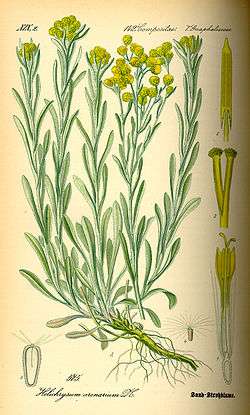Helichrysum arenarium
| Helichrysum arenarium | |
|---|---|
 | |
| Scientific classification | |
| Kingdom: | Plantae |
| (unranked): | Angiosperms |
| (unranked): | Eudicots |
| (unranked): | Asterids |
| Order: | Asterales |
| Family: | Asteraceae |
| Genus: | Helichrysum |
| Species: | H. arenarium |
| Binomial name | |
| Helichrysum arenarium (L.) Moench, 1794 | |
Helichrysum arenarium is also known as dwarf everlast, and as immortelle.[1]
Description
As a perennial plant, it grows to be an average of 0.3 m tall.
The leaves are flat, the lower ones being elliptical in shape, while the upper ones are linear. They are wooly on both sides.
The flower heads are arranged in loosely, a cross between umbel and panicle. They are 3 to 4 mm wide of bright golden yellow florets
It is found in Eastern France to Denmark as well as on the mountains of Uzbekistan on sandy grasslands, and heathland. It is also widely spread on the Dalmatian Coast in Croatia where locals regularly pick and sell it throughout the summer (weather permitting even as late as September and October).
Medical uses
An infusion of the bright yellow flowers is used in the treatment of gall bladder disorders and as a diuretic in treating rheumatism and cystitis. It is a component in zahraa, an herbal tea used for medicinal purposes in Syria.
It is being used also as a component of herbal fruit teas.
The dried plant is often used for decorative purposes along with, or instead of, its relative Helichrysum bracteatum.

from Thomé Flora von Deutschland, Österreich und der Schweiz 1885
Similar Species
Helichrysum stoechas is similar to the Helichrysum arenarium species, but the leaves are all linear, with rolled under Edges. It is found in western France on dunes near the sea.
References/citations
- ↑ Rose, Francis (1981). The Wild Flower Key. Frederick Warne & Co. pp. 377–380. ISBN 0-7232-2419-6.
| Wikimedia Commons has media related to Helichrysum arenarium. |